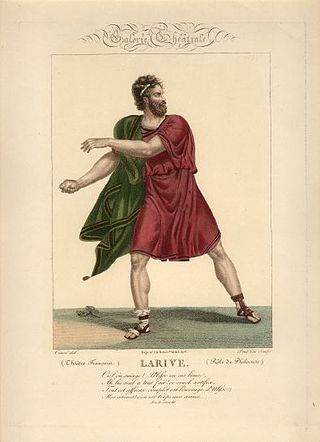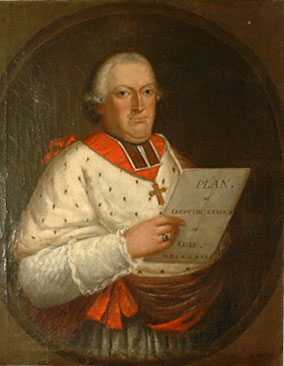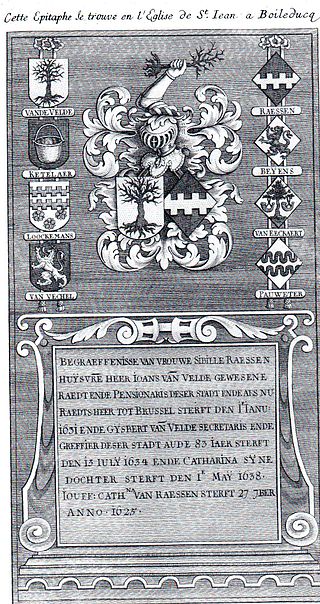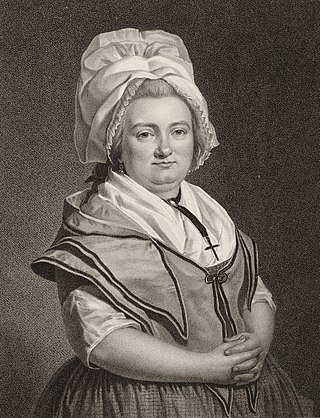Life
He was born in Grenoble, the son of the Florentine painter Giovanni Niccolò Servandoni (also known as Jean-Nicolas Servandoni) and his wife Marie-Josèphe Gravier, known for his façade for the église Saint-Sulpice in Paris. D'Hannetaire seems to have begun his acting career in Germany, around 1740. He played at the château d'Arolsen, for the prince of Waldeck, around 1743 and was in Aix-la-Chapelle in 1744, from whence he arrived in Liège around the end of the year. In November he presented a Divertissement nouveau de chants et de danses for prince-bishop Jean-Théodore of Bavaria and, also whilst in Liège, married the comic-actor Marguerite-Antoinette Huet (stage name Mademoiselle Danicourt) on 17 February 1745. The couple arrived in Brussels in October 1745 and D'Hannetaire took up leadership of the Théâtre de la Monnaie, from which he was dislodged four months later by Favart. He and his wife integrated into the troupe of maréchal de Saxe and he once again took direction of the theatre on the departures of the French troupes at the end of 1748.
He then played at Toulouse and Bordeaux, then made his debut at the Comédie-Française on 27 April 1752 in the rôle of Orgon in Tartuffe . However, he preferred to return to Brussels, in Durancy's troupe, in which he was entrusted "les rôles à manteaux" and "les rôles de Crispin". In 1755 he took over from Durancy as head of this troupe, and stayed so until 1771, sometimes alone, sometimes in association with other actors.
D'Hannetaire and his wife had 8 children, 2 of whom also became notable actors :
- Eugénie (1746–1816), married the comic-actor Larive, it was to her that the prince de Ligne dedicated his Lettres à Eugénie sur les spectacles (1774)
- Angélique (1749–1822), mistress of vicomte Desandrouins, then of the same prince de Ligne.
In 1768, he renounced acting to become a notary, in the historic context of the excommunication of actors "in virtue of an old usage of comedy". Nevertheless, he continued to act at Brussels for several years, before having to retire until his death in Brussels.

Charles-Joseph Lamoral, 7th Prince de Ligne in French; in German Karl-Joseph Lamoral 7. Fürst von Ligne : was a field marshal, inhaber of an infantry regiment, prolific writer, intellectual, member of the princely family of Ligne. He fought as a field officer during several famous battles during the Seven Years' War and briefly returned to military duty in the War of the Bavarian Succession. He performed an important diplomatic mission to Catherine the Great in 1787 and led troops against the Ottoman Empire at Belgrade in 1789. Beginning in the 1770s, he authored an impressive volume of work. After his estates in the Austrian Netherlands were lost to France during the War of the First Coalition, he lived in Vienna. All three of his sons died before him, but his wife and four daughters all outlived him. His grandson, the 8th Prince, became a Belgian statesman.

Philips of Marnix, Lord of Saint-Aldegonde, Lord of West-Souburg was a Flemish and Dutch writer and statesman, and the probable author of the text of the Dutch national anthem, the Wilhelmus.

The Comédie-Française or Théâtre-Français is one of the few state theatres in France. Founded in 1680, it is the oldest active theatre company in the world. Established as a French state-controlled entity in 1995, it is the only state theatre in France to have its own permanent troupe of actors. The company's primary venue is the Salle Richelieu, which is a part of the Palais-Royal complex and located at 2, Rue de Richelieu on Place André-Malraux in the 1st arrondissement of Paris.
Maximilian Emanuel, 3rd Prince of Hornes, Count of Baucignies and of Solre-le-Château, was a nobleman and Grand Huntsman of Brabant. His father was Philippe Emanuel, 2nd Prince of Hornes, and his mother was Princess Marie Anne Antoinette of Ligne.
Charles-Alexandre Bernard, known as Charles Bernardy, was a dancer, choreographer and dancing master.
Suzette Defoye née Marie-Suzanne-Joséphe Artus Truyart, was a French ballet dancer, stage actor, opera singer and theatre director, active in France, Belgium and Russia.
Jean-François Fieuzal or Fieusacq, stage name Durancy was a French actor-director and part of Charles Simon Favart’s acting troupe. He headed the Théâtre de la Monnaie in Brussels from 1 April 1752 until 15 March 1755. Afterwards, he was an actor in Bordeaux for some time. He made his debut at the Comédie-Française on 7 November 1759. Durancy married mademoiselle Darimath, with whom he conceived two daughters. The youngest of the two, Claire-Eulalie, was an actress in Brussels, while the oldest one, Céleste, acted for a long time at the Comédie-Française and the Opéra de Paris.

Marie-Louis-Philippine-Eugénie Servandoni, stage name Eugénie D'Hannetaire, was a French actress.

Jean Mauduit, stage name Larive or de La Rive was a French actor.
Marguerite-Louise Odiot de Montroty, stage name Sophie Lothaire was a French dancer, actress and director who spent her whole career at the Théâtre de la Monnaie in Brussels.

François Charles de Velbrück (1719–1784) was a German ecclesiastic. He was prince bishop of Liège from 16 February 1772 to his death on 30 April 1784.

Charles Monselet was a French journalist, novelist, poet and playwright, nicknamed "the king of the gastronomes" by his contemporaries. He specialised in comedic and romantic novels and his total output was around 40 volumes.

Beyens de Grambais is a Dutch-Belgian family of nobility, with a branch settling in the Southern Netherlands in the early 17th century.

Jean Charles Joseph, Count of Merode, Marquess of Deynze was a noble of the Austrian Netherlands, born in the Prince-Bishopric of Liège. He was Lieutenant-Feldmarschall of the Holy Roman Empire, Knight of the Order of the Golden Fleece.
Jean Guillemay du Chesnay, called Rosidor, was a 17th-century French playwright and actor.
Adolphe Grognier, known under the pseudonym Jean-Baptiste Quélus, was a French actor and singer. The son of lawyer Louis-Furcy Grognier (1777-1832), and Hélène Caylus, he was appointed twice as director of La Monnaie of Brussels, in 1854 and 1856.
Events in the year 1841 in Belgium.
Jean-Jacques Courvoisier was a Minim Friar from the County of Burgundy and a spiritual author in the Spanish Netherlands.
Anarchism spread into Belgium as Communards took refuge in Brussels with the fall of the Paris Commune. Most Belgian members in the First International joined the anarchist Jura Federation after the socialist schism. Belgian anarchists also organized the 1886 Walloon uprising, the Libertarian Communist Group, and several Bruxellois newspapers at the turn of the century. Apart from new publications, the movement dissipated through the internecine antimilitarism in the interwar period. Several groups emerged mid-century for social justice and anti-fascism.

Rose Françoise Carpentier called Madame Gonthier 7 December 1829, was a French actress and lyrical artist.









